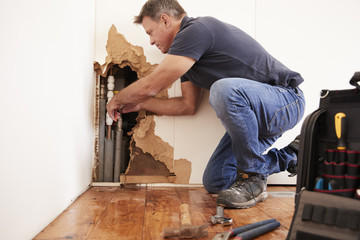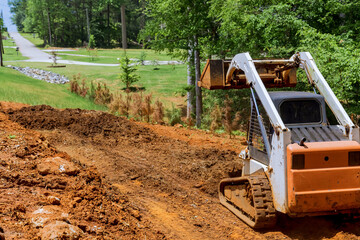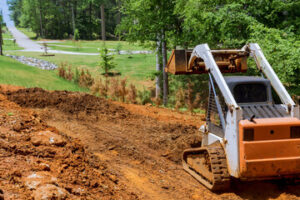Water damage is a serious problem that can cause a lot of harm to your home or business. It can weaken foundations, cause beams to warp and sag, and even lead to mold growth.
The first step in the process is inspection and assessment. A professional will determine the source of the water, the type of damage and affected materials. They will then create a plan of action including water extraction, drying and sanitization. Contact Water Damage Restoration Utah for professional help.
Water damage can be a serious problem, but you can reduce the risk of extensive repairs and cleanup costs by being proactive. Regularly inspecting plumbing systems and replacing hoses when they show signs of wear can prevent major leaks and damages. Taking other preventative measures like keeping gutters clean can also help to minimize the impact of water damage in your home.
While it is difficult to pinpoint a specific cost for water damage restoration, there are several critical factors that will influence the price of the work. The first factor is the scope of the damage. The cost of restoring a small area of water damage will be significantly less than the cost of repairing extensive flooding. The second factor is the type of water involved. Different types of water damage require different repair methods and can pose health hazards. Clean water damage, which comes from a sanitary source, is the least expensive to restore. Gray water, which contains contaminants, is more expensive to clean up and may require additional precautions. Black water, which is highly contaminated and poses a significant health hazard, can be the most costly to repair.
The location of the water damage can also affect the cost. Water damage in hard-to-reach areas, such as basements or crawl spaces, can take longer to dry and may require specialized equipment and techniques, which will increase the cost. In addition, the presence of secondary damage, such as mold growth or sewage backups, will require additional steps and add to the overall cost of the project.
The final factor that will influence the cost of water damage restoration is the time elapsed since the incident. The longer the water damage is left untreated, the more extensive the damage will be and the higher the cost of restoration. Therefore, it is important to seek prompt professional assistance after any incident resulting in water damage.
Time
The timeline for water damage restoration can vary greatly depending on the severity of the situation and the type of materials affected. The key to minimizing damage is quick response and professional help. The more time the water has to sit, the more extensive the damage will be and the longer it will take to repair. By acting promptly, you can avoid costly repairs and help ensure your property retains its value.
In addition, the sooner you respond to water damage, the less likely it is that mold will grow and the extent of the damage will increase. Mold growth can deter potential buyers and tenants, which can impact your property value. It can also lead to a variety of health problems, including asthma, allergies, and other respiratory issues. Water damage restoration will prevent mold and fungus from growing, reducing the risk of health problems for your family or your tenants.
Mitigation is the first step in the water restoration process, and it can be very time-consuming. It begins with a thorough inspection of the affected area to determine the extent of the damage. This includes checking for standing water, water stains, and swelling. It also involves turning off electricity and gas if necessary. Once the area is safe, water is removed with powerful pumps and vacuums. In addition, industrial-grade drying equipment is set up to reduce moisture levels and promote evaporation.
This stage can take a few days to complete, but it is critical to the success of the restoration process. It is important to establish clear communication with your restoration team from the start to ensure everyone understands what needs to be done and how long it will take.
Once the area is dry, structural repairs can begin. This may involve replacing damaged framing, drywall, and insulation. It may also include repairing or replacing flooring and electrical systems. Mold remediation and sanitization are often part of the restoration process, as well.
The restoration process can take several weeks to months. It is important to consult with a professional restoration company like Double Clean Restoration to get the best results and minimize costs.
Precautions
When dealing with water damage, it is important to take precautions both to protect yourself and the property. Taking the proper measures will save you time, money, and potential health risks. The first thing you should do is shut off the source of water. This will help prevent further damage and prevent the spread of mold spores. It is also important to remove any items that are soaked in water. This includes rugs, mattresses, and furniture. These should be removed and stored in a dry area until they can be cleaned. Additionally, it is a good idea to keep important documents safe and secure.
Identifying the source of the water is also crucial to protect yourself and your property. Different types of water require different restoration processes. Clean water, or Category 1, comes from a sanitary source such as rain or leaky pipes. Gray water, or Category 2, comes from non-sanitary sources such as washing machines and toilets that overflow. Finally, contaminated or dirty water, or Category 3, is dangerous and can cause disease. It usually comes from sewage or toilets and requires extensive restoration and disinfection.
It is also a good idea to arm yourself with an assortment of disinfectants. You will need these to disinfect porous materials and surfaces such as drywall, wood, and fabric. You should also disinfect any objects that have been soaked in water and may contain bacteria. This will ensure that you don’t bring these contaminants into your home or office space.
The longer the affected areas are left unchecked, the more costly and extensive the damage will be. This is because the moisture will continue to penetrate porous materials and slowly destroy them. This can lead to warping and shrinking, as well as the formation of mildew and mold.
To avoid these problems, it is important to contact a professional water damage restoration company immediately. They will have the equipment and expertise needed to restore your property quickly and thoroughly. In addition, they will be able to assess the situation and recommend any necessary repairs. They will also be able to provide you with an estimate of the costs involved, which can be helpful when filing insurance claims.
Insurance
Water damage can wreak havoc on your property, causing significant structural damage, mold growth, and health risks. It can also ruin valuable possessions and reduce the value of your home or business. Fortunately, you can mitigate the financial burden of repairing and restoring your property by obtaining adequate insurance coverage. Water restoration services are typically covered by homeowner’s insurance policies and commercial property insurance plans. By carefully documenting the damage, promptly contacting your insurer, and partnering with a qualified water damage restoration service provider, you can increase your chances of a successful claim.
The type of coverage you need for water damage depends on the cause and extent of the damage, as well as your insurance policy. Flood insurance is typically not required by homeowners’ insurance, but it may be recommended in areas prone to flooding. Homeowners’ insurance typically covers damage caused by burst pipes, overflowing appliances, and sewer or water backup. The insurance company will assess the situation and determine if the damage is sudden and accidental or gradual. If the damage is gradual, the insurance company will likely deny a claim.
Insurance companies will also consider if the cause of the damage was due to negligence or not. If the insurance company determines that the property owner was negligent, it can deny coverage. Performing regular maintenance and addressing issues immediately can prevent this from happening.
Water damage restoration involves the process of restoring your property to its pre-damaged condition. This includes removing debris, drying and cleaning materials, and sanitizing the affected area. The restoration process can take a few days or weeks, depending on the severity of the water damage. It is important to hire a professional water damage restoration company that uses environmentally friendly practices.
During the restoration process, it is crucial to thoroughly document the damage with photographs and notes. This will help the insurance adjuster evaluate and repair the damage. It is also important to communicate clearly and avoid making assumptions. This will ensure a successful insurance claim and an efficient restoration process. A qualified water restoration company can provide a comprehensive inspection of your property and recommend appropriate measures for repair and prevention of future problems.




